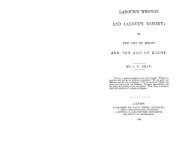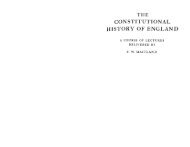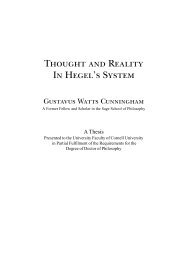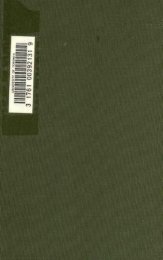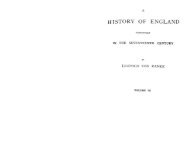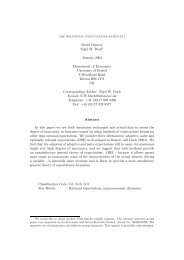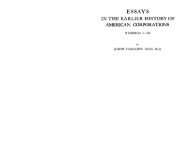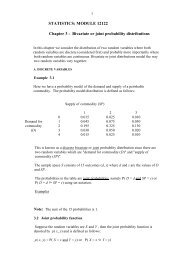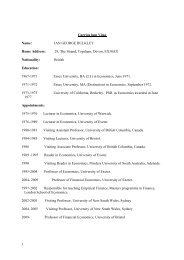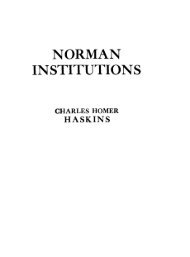TEXTILESwas paid better than the labourer who worked forthem all the year round, and whose family dependedexclusively on him. Disorganization and lack <strong>of</strong> bargainingpower, coupled with traditions founded uponan earlier social organization, were responsible for thelow wages <strong>of</strong> the spinsters. The agricultural labourerwas crippled in his individual efforts for a decent wagebecause society persisted in regarding him as a householdservant. The spinster was handicapped because in asociety which began to assert the individual's right t<strong>of</strong>reedom, she had from her infancy been trained tosubjection.It must however be remembered that though a largepart <strong>of</strong> the ensuing chapter is concerned with spinstersand their wages, much, perhaps most, <strong>of</strong> the threadspun never came into the market, but was produced fordomestic consumption. Thus we find all three forms<strong>of</strong> industrial organisation existing simultaneously inthese trades-Domestic Industry, Family Industry,and Capitalistic Industry.Domestic Industry lingered especially in the LinenTrade until machinery made the spinning wheelobsolete, and Family Industry was still extensivelypractised in the <strong>seventeenth</strong> <strong>century</strong> ; but CapitalisticIndustry, already established in the Woollen Trade,was making rapid inroads on the other branches <strong>of</strong> theTextile Trades.Although Capitalism undermined the position <strong>of</strong>considerable economic independence enjoyed bymarried <strong>women</strong> and widows in the tradesman andfarming classes, possibly its intoduction may haveimproved the position <strong>of</strong> unmarried <strong>women</strong>, andothers who were already dependent on wages ; butsuch improvements belong to a later date. Theironly indication in the <strong>seventeenth</strong> <strong>century</strong> is the clearlyproved fact that wages for spinning were higher in themore thoroughly capitalistic woollen trade, than in thelinen trade. Further evide'nce is a suggestion by DefoeTEXTILES97that wages for spinning in the woollen trade weredoubled, or even trebled, in the first decade <strong>of</strong> theeighteenth <strong>century</strong>, but no sign <strong>of</strong> this advance canbe detected in our period.(B.) Woollen Trade.The interest <strong>of</strong> the Government and <strong>of</strong> all those whostudied financial and economic questions, was focussedupon the Woollen Trade, owing to the fact that itformed one <strong>of</strong> the chief sources <strong>of</strong> revenue for theCrown. At the close <strong>of</strong> the <strong>seventeenth</strong> <strong>century</strong>woollen goods formed a third <strong>of</strong> the English exports.'Historically the Woollen Trade has a further importance,due to the part which it played in the development<strong>of</strong> capitalism. The manufacture <strong>of</strong> woollenmaterials had existed in the remote past as a familyindustry, and even in the twentieth <strong>century</strong> this methodstill survives in the remoter parts <strong>of</strong> the British Isles ;but the manufacture <strong>of</strong> cloth for Foreign trade wasfrom its beginning organized on Capitalistic lines, andthe copious records which have been preserved <strong>of</strong> itsdevelopment, illustrate the history <strong>of</strong> Capitalismitself.It was estimated that about one million men, <strong>women</strong>and children were exclusir.ely employed in the clothingtrade,-" all have their dependence solely and whollyupon the said Manufacture, without intermixingthemselves in the labours <strong>of</strong> Hedging, Ditching,Quickretting, and others the works belonging toHusbandry."'In 1612 eight thousand persons, men, <strong>women</strong> and-p----' Davenant (Inspector-General <strong>of</strong> Exports and Irnrorts). An account <strong>of</strong>tbc tradebetween Greate Brztazn, Franre, Holland, Spurn, Portup Italy, Afrrca, Newfoundlandetc. wzth the zmportatzons and exportatzons <strong>of</strong> all Commodttres, partrcularly <strong>of</strong> theWoollen Manufactures, deltoered zn hzs reports made to the Commtsszoners for PubltckAccounts. 1715, p. 71. Our general exports for the year 1699 are valued atE6, 788,166, 17s 63d. Where<strong>of</strong> the Woollen Manufacture for the same year arevalued at Lr,93z,z9z, 17s. 63d.Prozerb Crossed, p. 8, 1677. See also Case <strong>of</strong> the Woollen Manufacturers <strong>of</strong> GreatBrztnrn which states that they are " the subsistance <strong>of</strong> more than a Million <strong>of</strong> Poor<strong>of</strong> both sexes, who are employed there~n."
TEXTILESchildren were said to be employed in the clothingtrade in Tiverton alone.' While giving 933,966 handsas the number properly employed in woollen manufacture,another writer says that <strong>women</strong> and children(girls and boys) were employed in the proportion <strong>of</strong>about eight to one man.'Such figures must be taken with reserve, for theproportions <strong>of</strong> men and <strong>women</strong> employed variedaccording to the quality <strong>of</strong> the stuff woven, andpamphleteers <strong>of</strong> the <strong>seventeenth</strong> <strong>century</strong> handledfigures with little regard to scientific accuracy.' Butthe uncertainty only refers to the exact proportion ;there can be no doubt that the Woollen Trade dependedchiefly upon <strong>women</strong> and children for its labour supply.For the student <strong>of</strong> social organization it is noteworthythat in the two textile trades through whichcapitalism made in England its most striking advances-the woollen trade, and in later years, the cottontrade, the labour <strong>of</strong> <strong>women</strong> predominated,-a factwhich suggests obscure actions and reactions betweencapitalism and the economic position <strong>of</strong> <strong>women</strong>, worthy<strong>of</strong> more careful investigation than they have as yetreceived.The woollen trade passed through a period <strong>of</strong> rapidprogress and development in the sixteenth <strong>century</strong>. Itwas then that the Clothiers <strong>of</strong> Wiltshire and Somersetacquired wealth and fame, building as a memorialfor posterity the Tudor houses and churches which' Dunsford. Hist. Tiverton, p. 408.Short Essay upon Trade, p. 18, 1741.' The following estimates were made by different writers : out <strong>of</strong> 1187 penonssupposed to be employed for one week in making up 1200 Ibs weight <strong>of</strong> wool, gmare given as spinners. (Wearers True Case, p. 42, 1714.)One pack <strong>of</strong> short wool finds employment for 63 persons for one week, viz : 28 menand boys : 35 <strong>women</strong> and girls who are only expected to do the carding and spinning.A similar pack made into stockings would protide work for 82 men and 102 spinnersand if made up for the Spanish trade, a pack <strong>of</strong> wool would employ 52 men and 250<strong>women</strong>.(Haynes (John) Great Britain's Glory, p. 6, p. 8. 1715.)TEXTILESstill adorn these counties. Leland, writing <strong>of</strong> a typicalclothier and his successful enterprises and ambitions,describes at Malmesbury, Wiltshire " a litle chirchjoining to the South side <strong>of</strong> the Trans~ptum <strong>of</strong> thabbychirch,. . . Wevers hath now lomes in this litlechirch, but it stondith . . . the hole logginges<strong>of</strong> thabbay be now longging to one Stumpe, an excedingriche clothiar that boute them <strong>of</strong> the king. ThisStumpes sunne hath maried Sir Edward Baynton7sdoughter. This Stumpe was the chef causer andcontributer to have thabbay chirch made a parochchirch. At this present tyme every corner <strong>of</strong> the vasrehouses <strong>of</strong> <strong>of</strong>fice that belongid to thabbay be fulle<strong>of</strong> lumbes to weve clooth yn, and this S tumpe entendithto make a stret or 2 for clothier in the bak vacantground <strong>of</strong> the abbay that is withyn the toune waulles."'There must have been a marked tendency at this timeto bring the wage-earners <strong>of</strong> the woollen industryunder factory control, for a description which is given<strong>of</strong> John Winchcombe's household says that" Within one room being large and longThere stood two hundred Looms full strong,Two hundred men the truth is soWrought in these looms all in a row,By evry one a pretty boySate maklng quills with mickle joy.And in another place hard by,An hundred <strong>women</strong> merrily,Were carding hard w~th joyf~ll cheerWho singing sate with voices clear.And in a chamher close beside,Two hundred madens d~d ab~de,In petticoats <strong>of</strong> Stammell red,And m~lk-white kerchers on their head." aThese experiments were discontinued, partly becausethey were discountenanced by the Government, whichconsidered the factory system rendered the wage-earnerstoo dependent on the clothiers ; and also becausethe collection <strong>of</strong> large numbers <strong>of</strong> workpeople under one' Leland (John) Itinerary, 1535-1543 ; Part 11, pp. 131-2.%lpson, Econ. IZist. <strong>of</strong> England, p. 420.
- Page 1 and 2: WORKING LIFE OF WOMENIN THESEVENTEE
- Page 6 and 7: 4 INTRODUCTORYtragic class of wage
- Page 8 and 9: 8 INTRODUCTORY INTRODUCTORYDomestic
- Page 10 and 11: INTRODUCTORYunmarried girls go out
- Page 12 and 13: I 6 CAPITALISTS CAPITALISTS" I loos
- Page 14 and 15: CAPITALISTSweak woman stands in the
- Page 16 and 17: 24 CAPITALISTS CAPITALISTS 25wife t
- Page 18 and 19: 2 8 CAPITALISTS CAPITALISTS 29Majes
- Page 20 and 21: 32 CAPITALISTSA warrant was issued"
- Page 22 and 23: CAPITALISTSbusiness. " At O~tend, N
- Page 24 and 25: CAPITALISTS CAPITALISTS41thro' her
- Page 26 and 27: AGRICULTUREwas made of their develo
- Page 28 and 29: AGRICULTUREis not drye as it should
- Page 30 and 31: 52 AGRICULTURE AGRICULTUREhave of h
- Page 32 and 33: 56 AGRICULTUREfor colonists in Virg
- Page 34 and 35: AGRICULTUREmaintain completely the
- Page 36 and 37: 64 AGRICULTUREtime was well spent i
- Page 38 and 39: AGRICULTUREExcept in exeptional cir
- Page 40 and 41: 72 AGRICULTURE AGRICULTURE 73mainta
- Page 42 and 43: 76 AGRICULTUREfor the impotent poor
- Page 44 and 45: AGRICULTUREwhich we can imagine tha
- Page 46 and 47: AGRICULTURE AGRICULTURE 85by his se
- Page 48 and 49: AGRICULTUREher work, but generosity
- Page 50 and 51: AGRICULTUREwife of Thos. Lyne. Toba
- Page 54 and 55: TEXTILESroof provided them with the
- Page 56 and 57: 104 TEXTILESformulated by 25 Charle
- Page 58 and 59: 108 TEXTILES TEXTILES 109until the
- Page 60 and 61: TEXTILESon spinning for their livin
- Page 62 and 63: TEXTILESstill and dry within Doors,
- Page 64 and 65: 120 TEXTILES TEXTILESthe cloth made
- Page 66 and 67: 124TEXTILES TEXTILESin the closely
- Page 68 and 69: TEXTILESKingdom, it required a grea
- Page 70 and 71: 132 TEXTILES TEXTILESnot exceedl6 1
- Page 72 and 73: TEXTILES TEXTILES I37hours in four
- Page 74 and 75: ---P-I 4OTEXTILEScan be quoted of t
- Page 76 and 77: '44 TEXTILES TEXTILESWood Streate,
- Page 78 and 79: TEXTILEShigher wages than would hav
- Page 80 and 81: 1 52 CRAFTS AND TRADESdebts. For ex
- Page 82 and 83: I 56 CRAFTS AND TRADES CRAFTS AND T
- Page 84 and 85: 160 CRAFTS AND TRADES CRAFTS AND TR
- Page 86 and 87: 164 CRAFTS AND TRADESAmong thirty-n
- Page 88 and 89: CRAFTS AND TRADESalso met with as b
- Page 90 and 91: 172 CRAFTS AND TRADES CRAFTS AND TR
- Page 92 and 93: 176 CRAFTS AND TRADESto Henry Joyce
- Page 94 and 95: 180 CRAFTS AND TRADES CRAFTS AND TR
- Page 96: CRAFTS AND TRADESWardens and Brothe
- Page 99 and 100: P-I9OCRAFTS AND TRADESmarriage ; it
- Page 101 and 102: CRAFTS AND TRADEStaken our goods fr
- Page 103 and 104:
1g8CRAFTS AND TRADESresources turne
- Page 105 and 106:
CRAFTS AND TRADESThere were fewer r
- Page 107 and 108:
206 CRAFTS AND TRADES CRAFTS AND TR
- Page 109 and 110:
CRAFTS AND TRADESA large proportion
- Page 111 and 112:
214CRAFTS AND TRADES CRAFTS AND TRA
- Page 113 and 114:
218 CRAFTS AND TRADES CRAFTS AND TR
- Page 115 and 116:
222 CRAFTS AND TRADES CRAFTS AND TR
- Page 117:
CRAFTS AND TRADES CRAFTS AND TRADES
- Page 120 and 121:
CRAFTS AND TRADESfrom her fellow pa
- Page 122 and 123:
PROFESSIONS 237PROFESSIONSIntroduct
- Page 124 and 125:
24O PROFESSIONS PROFESSIONStheir Th
- Page 126 and 127:
244 PROFESSIONS PROFESSIONS 245the
- Page 128 and 129:
PROFESSIONS PROFESSIONS 249profanat
- Page 130 and 131:
252PROFESSIONSGiles Moore enters in
- Page 132 and 133:
PROFESSIONScribed as one who " dist
- Page 134 and 135:
PROFESSIONS PROFESSIONS 261first ma
- Page 136 and 137:
264 PROFESSIONSGarrett's leg shall
- Page 138 and 139:
268 PROFESSIONSwhere there are none
- Page 140 and 141:
PROFESSIONS PROFESSIONS 273the numb
- Page 142 and 143:
PROFESSIONSexaminations, before six
- Page 144 and 145:
PROFESSIONS PROFESSIONS 281death me
- Page 146 and 147:
284 PROFESSIONS PROFESSIONSof confi
- Page 148 and 149:
288 PROFESSIONSextent they were whe
- Page 150 and 151:
CONCLUSIONor in her other facilitie
- Page 152 and 153:
CONCLUSION CONCLUSION 297in women's
- Page 154 and 155:
CONCLUSIONlaw of Nature, inviolable
- Page 156 and 157:
CONCLUSIONwere specially deprecated
- Page 158 and 159:
308 CONCLUSIONof the State, and the
- Page 160 and 161:
312 AUTHORITIES AUTHORITIES 313Cost
- Page 162 and 163:
AUTHORITIESMartindale, Adam, The Li
- Page 164 and 165:
County.Buckingham ..Cardigan .. ..C
- Page 166 and 167:
INDEXINDEXFlax, 64, 146, 246, 291 ;
- Page 168:
INDEXsmants, women( 50,65,157 ; mam



